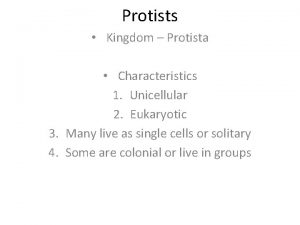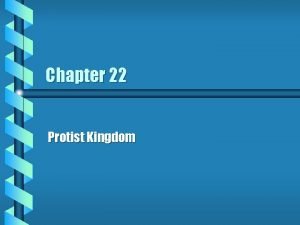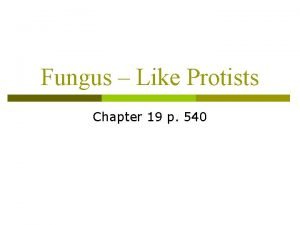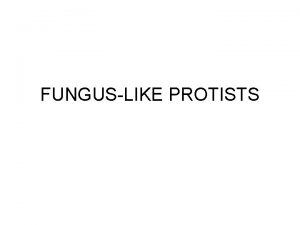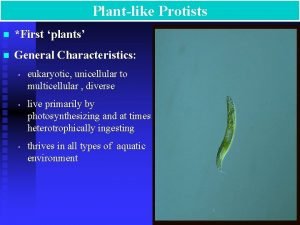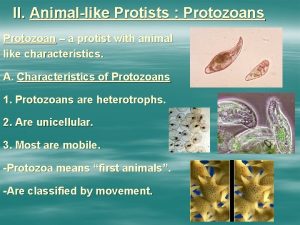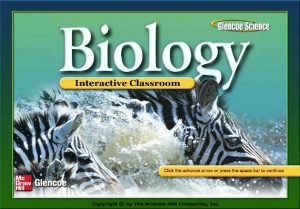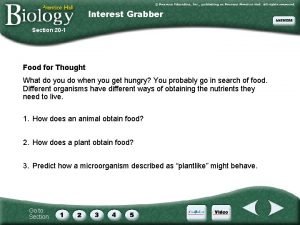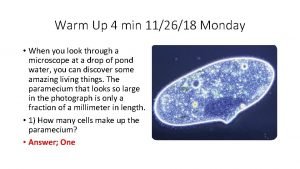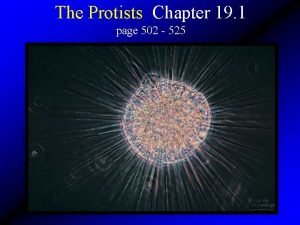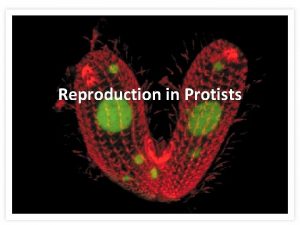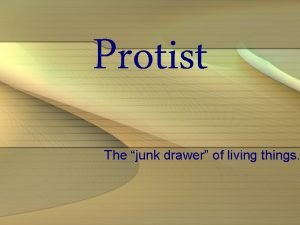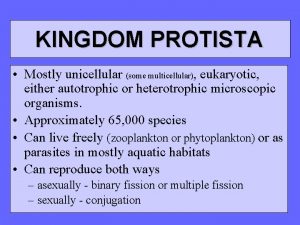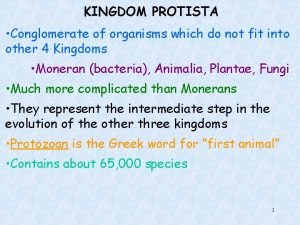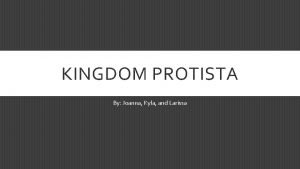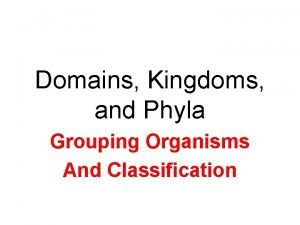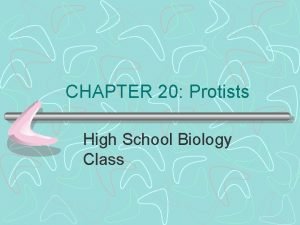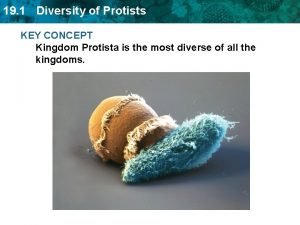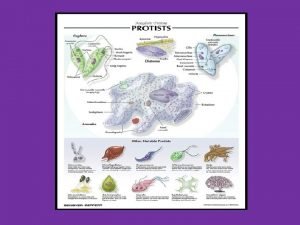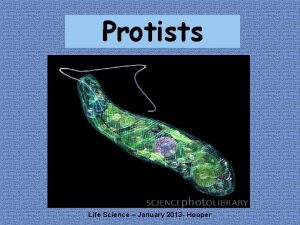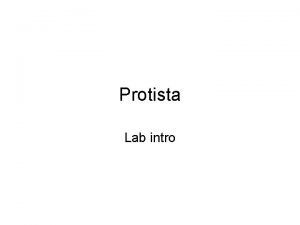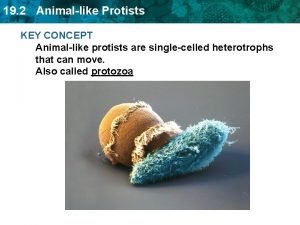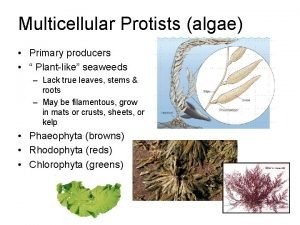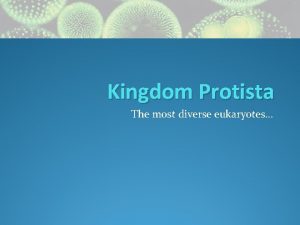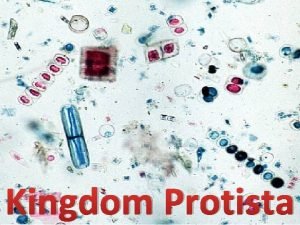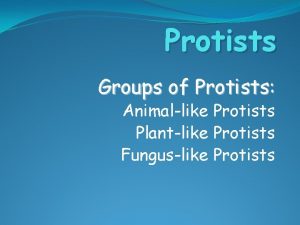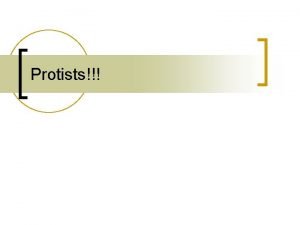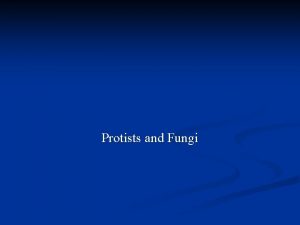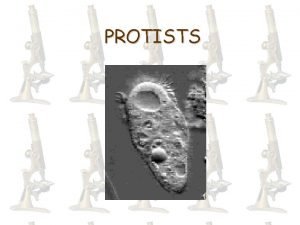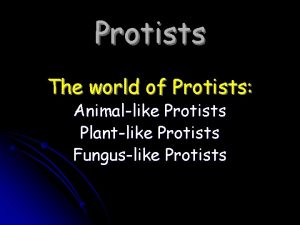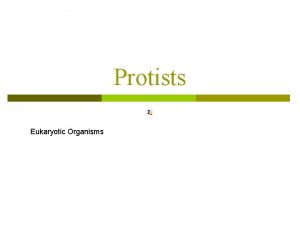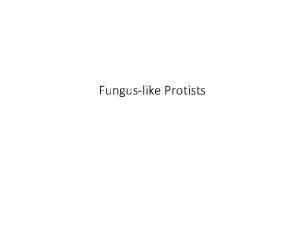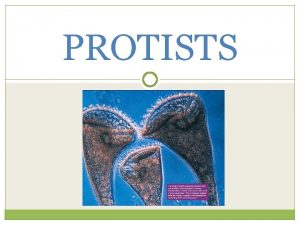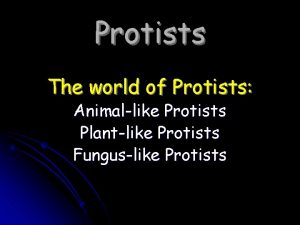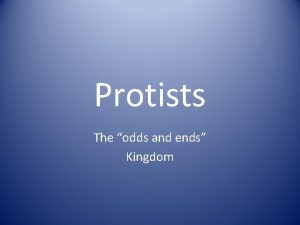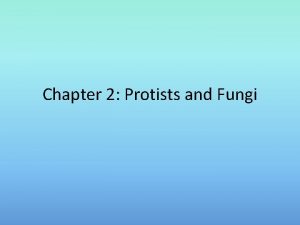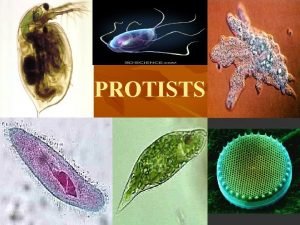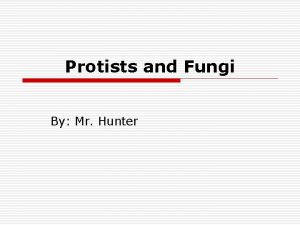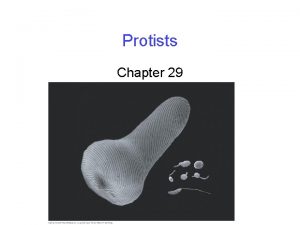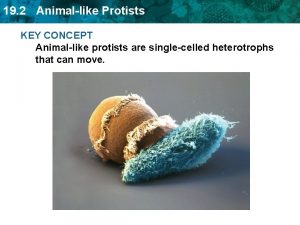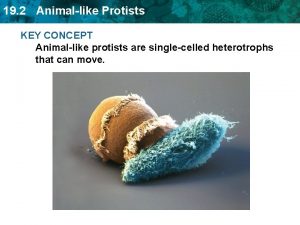PROTISTS Section I Characteristics of Protists Section II


































- Slides: 34

PROTISTS Section I – Characteristics of Protists Section II – Groups of Protists Section III – Protists & Humans

What are Protists? Kingdom of Protista – made up of organisms that do not belong in any other kingdom. n This kingdom is the most diverse of all six kingdoms. n They all have one thing in common THEY ALL ARE EUKARYOTIC n

General Characteristics In Protists Eukaryotes – have a nucleus & membrane bound organelles n Most are unicellular {Some are colonial or multicellular n Can be autotrophs or heterotrophs n Complex Cilla & Flagella n Sexual Reproduction with gametes n Multicellularity n

How Do Protists Reproduce? Protists can reproduce either asexually or sexually Asexual reproduction results in offspring that are genetically identical to the parent. Sexual Reproduction results in offspring that are genetically different from wither parent.

How do Protists reproduce asexually ? 1) Binary Fission – a unicellular organism The organism splits in half after replicating its DNA. In eukaryotic cells this process is called mitosis. 2) Budding – Part of the parent organism pinches off and forms a new organism. 3) Fragmentation – Part of a multicellular organism breaks off and grows into a new organism.

How do Protists reproduce sexually? Sexual reproduction occurs as a response to environmental stress 1) Sexual Reproduction in Unicellular Protists. This haploid cell divides by binary fission to produce haploid gametes. The two gametes fuse to form a diploid zygote, which becomes a zygospore. Meiosis occurs within the zygospore , when environmental conditions improve. The haploid cells break out of the zygospore & grow into mature cells.

Example - Life Cycle of Chlamydomonas - Unicellular

Sexual Reproduction in Protists Cont’d 2) Sexual Reproduction in Multicellular Protists Many can reproduce both sexually & asexually This process is called alternation of generationsconsisting of two distinct forms that differ in method of reproduction. A) The diploid, spore producing phase is called the sporophyte generation. B) The haploid, gamete-producing phase is called gametophyte generation.

Example – Life Cycle of Ulva, sea lettuce, Multicellular sexual reproduction

Classifying Protists The relationship between protists & developing a classification system that reflects these relationships is ongoing & is likely to change as scientists learn more about how these organisms are related to each other & other kingdoms

Groups of Protists The protists include snail-like creatures, giant kelp, yellow slime molds & many other organisms. They have very little in common “How do we discuss them in an Organized way? ” One common way to group them is by their source of nutrition – they can be divided into 3 groups: 1) Animal-like protists 2) Plant-like protists 3) fungus-like protists

The Three Groups of Protists: ANIMAL LIKE PROTISTS 1. Called Protozoans 2. Unicellular 3. No cell wall 4. Hetertrophs – Do not make their own food “They ingest other organisms for energy” No chloroplasts 5. Grouped by the way they move 6. Habitat – Free living – aquatic or moist habitat If mobile, they might be parasites living in bodily fluids of host

Example – Amoeba {Phylum Sarcodina} Move with “pseudopods” – false feet Jelly-like structure Cell shape changes constantly Nucleus Feed by phagocytosis – engulf food with pseudopods form food vacuoles Habitat – Free-living, some parasitic Live in water & moist soil

Picture of an Amoeba & a Flagellate

Example - Flagellates {Phylum Zoomastigina} Flagellates – Are protists that have whip-like tails for movement. Some have one or more flagella for movement. Habitat – Live in moist environments Some free-living in ponds, some are parasites that cause disease.

Example – Ciliates {Phylum Ciliphora} Move by beating cilia, tiny hair-like structures Habitat- Free –living, live in an aquatic environment , fresh water or marine Structure- Pellicle, hard shell covering cell Ex: Paramecium reproduce by binary fission has complex organelles – 2 nuclei contractile vacuole – pumps out excess water to maintain homeostasis

Example of Paramecium

Example – Sporozoan {Phylum Sporozoa} Animal-like protists that form sporelike cells when they produce. They are ALL parasitic Lack flagella & cilia – they can not move Reproduce asexually & sexually Ex: Plasmodium – carries malaria They reproduce in mosquitos, spores migrate to the salivary glands, spores are injected while feeding, reproduce again inside host, spores are released inside the blood – they rupture releasing toxins.

Plantlike Protists Plantlike protists include he organisms commonly known as phytoplankton & algae “Obtain energy through photosynthesis” These protists are the major producers in the aquatic ecosystems. Different kinds of plantlike protists use different pigments for photosynthesis.

Six Types of Plantlike Protists 1) Diatoms – Marine & Freshwater They are photosynthetic, unicellular with unique double shells that are glassy used for abrasives. They form oils for them to have a strong taste. 2)Euglena – Freshwater They are photosynthetic & hetertrophic, unicellular Traits that are similar to plants – cell wall & chlorophyll Traits that are similar to animals – move with flagella & respond to light using an eyespot, light sensitive organelle

Plantlike Protists Cont’d 3) Dinoflagulates – Many found in salt water, Unicellular, some are hetertrophic. They have 2 flagella for movement They have cellulose coats for protection **Some produce toxins when they bloom – Called “RED TIDE” kills fish or makes them sick

4) Red Algae – found in warm oceans, Mostly multicellular, calcium carbonate found in the cell walls of some of them, pigments that can absorb blue light in deep water. They attach to rocks at the bottom of the ocean 5) Brown Algae – found in cool oceans, multicellular, the only algae that have differentiated Tissues, a root-like holdfast, a stem-like stipe, and leaf-like blades. Ex: Seaweed or Kelp 6) Green Algae – Freshwater, unicellular & Multicellular, they use the same photosynthetic pigments that plants do, they have chloroplasts. Make up photoplankton = the base of the fresh water ecosystem food chain

Examples of Red, Brown & Green Algae

Funguslike Protists Fungusllike protists absorb nutrients from their environment & reproduce by releasing spores. Scientists once classified them as fungi however genetic studies show that they are not closely related. Funguslike protists include slime molds, water molds and downy mildew. Water molds & downy mildews break down or decompose, dead organisms. Others are parasites. Cellular slime molds usually live as separate cells, under dry conditions or when there is little food , the cell form colonies & release spores. This colony formed is a: Plasmodium – a mass of cytoplasm that has many nuclei.

Example of Funguslike Protists

Protists & Humans Protists have dramatic effects on human & other organisms – they can cause disease & alter ecosystems. They are useful in research and in industry. Parasitic protists are a significant cause of illness & death in today’s developing world. What are seven types of diseases caused by Protists?

Seven diseases caused by Protists 1) Giardiasis (Giardia) – Severe diarrhea & cramps Caused by drinking water that is contaminated with animal feces. Ex: campers & hikers who drink untreated water 2) Amoebic Dysentery – Pain, bloody diarrhea, fever; liver, lung or brain damage, death (rarely) Ex: From poor sanitation, can be transmitted on fruit, vegetables, that have been washed with contaminated water or eaten raw.

3) Toxoplasmosis – Flu-like symptoms, nerve, brain or eye damage (rarely); can cause birthdefects Caused by eating under cooked meat or through the feces of an infected cat. Ex: if a pregnant women is infected her infant may suffer eye or brain damage 4) Trichomoniasis. One of the most commonly sexually transmitted infections. Women & Men can spread. Ex: Can be treated with medication

5) Cryptosporidiosis. Severe cramps & Diarrhea Caused by contaminated water or objects; in uncooked food. 6) Chagas Disease – Can damage the heart, esophagus, & large intestine Caused through the feces of the kissing bugs Occurs in South or Central America 7) Malaria – anemia & cycles of fever; can lead to ruptured spleen, kidney failure, coma, brain damage, & death. Caused by the bite of an infected mosquito.

Examples of Diseases

Protists & the Environment Protists produce oxygen, take up carbon dioxide are very important producers in aquatic food webs, can produce deadly blooms serve as nutrient recycle and have symbiotic relationships with many animals & plants. 1)Oxygen production & Nutrient Cycling – plantlike protists produce at least half the earth’s oxygen 2) Food Webs – photosynthetic protists form the base of almost all aquatic food chains 3) Algal blooms – during warm seasons, algal population can rise – it is a rapid increase in the population of algal in the aquatic ecosystem. 4) Protist symbioses – make up about 15 % of protists, which also include the ones that cause diseases. Many supply coral with nutrients and its color.

Example of Algal Bloom & Red Tide

Protists & Industry Protists are important in many foods, in industrial & consumer products & in scientific research. 1) Many types of algae are eaten as vegetables 2) Algae produce substances that can thicken food products for example – ice cream, salad dressings, & gelatin desserts. 3) Agar is used to grow bacteria to make the gelatin capsule on medicines. 4) Some are used to make toothpaste, paint, cosmetics, & firefighting foam. 5) Protists are used in biological research – used to study ribosomes, cell aging & cell cycle control. They also help with models of cell movement, cell signaling, & how white blood cells fight disease.

Examining Protists
 Sporozoa
Sporozoa Zygnema locomotion
Zygnema locomotion Fungus like protist
Fungus like protist Phylum myxomycota
Phylum myxomycota Are protists unicellular or multicellular
Are protists unicellular or multicellular Plant like protists characteristics
Plant like protists characteristics Zooflagellates
Zooflagellates Section 1 introduction to protists answer key
Section 1 introduction to protists answer key Section 20-2 animal like protists protozoans
Section 20-2 animal like protists protozoans What kingdom is considered the ods and ends kingdom?
What kingdom is considered the ods and ends kingdom? Brainpop protists
Brainpop protists Chapter 19 protists study guide answers
Chapter 19 protists study guide answers Asexual reproduction in protists
Asexual reproduction in protists Protists
Protists Why is protista the junk drawer of kingdoms
Why is protista the junk drawer of kingdoms Kingdom fungi and kingdom plantae similarities
Kingdom fungi and kingdom plantae similarities Multicellular protista
Multicellular protista Are protists heterotrophic or autotrophic
Are protists heterotrophic or autotrophic Pseudopodia
Pseudopodia Animal like protists
Animal like protists Protist brainpop answers
Protist brainpop answers Kingdom protista classification chart
Kingdom protista classification chart Structural and functional diversity in protists
Structural and functional diversity in protists Fun fact about protists
Fun fact about protists Diversity of protists
Diversity of protists Single cell protist
Single cell protist Protists cell wall
Protists cell wall Kingdom protista habitat
Kingdom protista habitat Photosynthesis protists
Photosynthesis protists Animal-like protist
Animal-like protist Are protists producers
Are protists producers Categories of protists
Categories of protists Protista examples
Protista examples The protist kingdom
The protist kingdom 3 groups of protists
3 groups of protists
